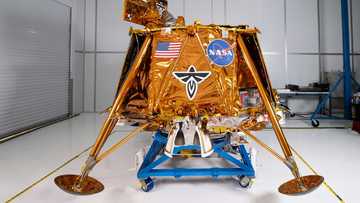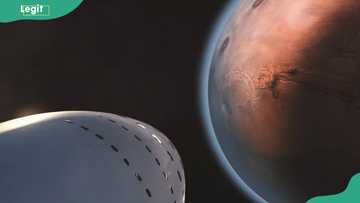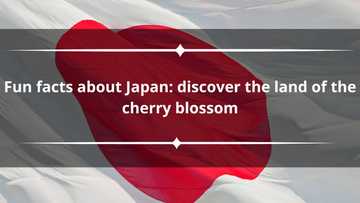25 fun facts about Uranus: discover the wonders of the seventh planet
Uranus is a fascinating world, a gas giant made of ice. It is the seventh planet from the Sun, the third largest planet in mass and size, and one of the solar system's less dense planets. If you want to know more about the planet, here are fun facts about Uranus. Dr. Stephanie Jarmak, the Planetary Science Project Scientist for NASA's Science Explorer (SciX), offers insights into Uranus, its unique characteristics and atmospheric features, recent discoveries, and how its rings compare to Saturn's.
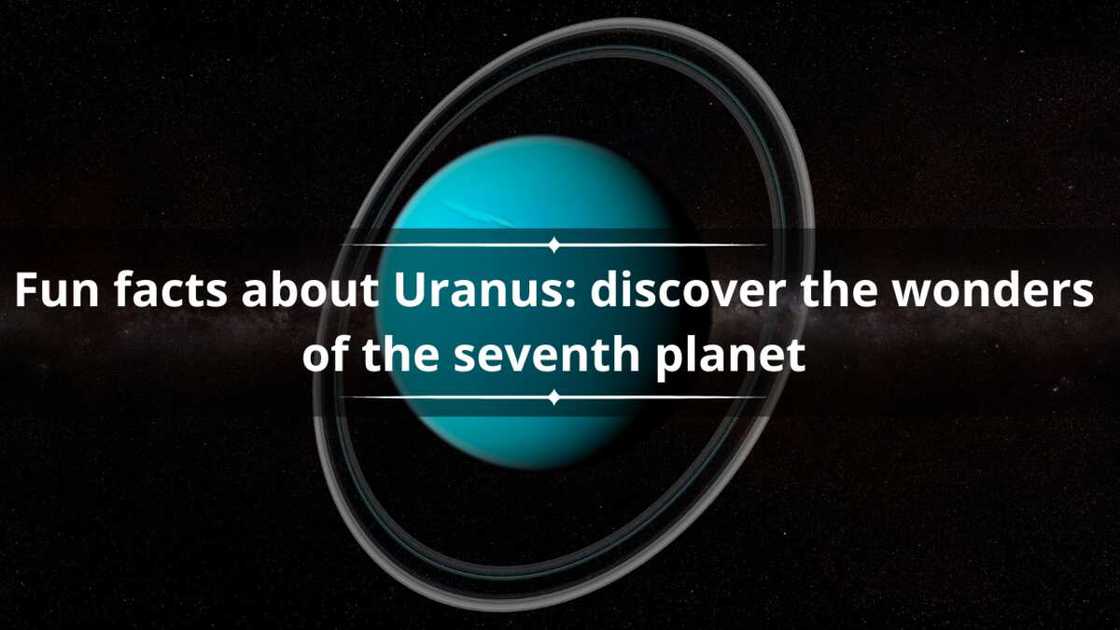
Source: Getty Images
TABLE OF CONTENTS
- What makes Uranus unique compared to other planets in our solar system?
- Prominent features of Uranus' atmosphere
- How do Uranus' rings compare to Saturn's, and what makes them unique?
- Are there any recent discoveries or missions related to Uranus that have enhanced our understanding of the planet?
- Fun facts about Uranus
- 1. Sir. William Herschel formally discovered it
- 2. It's the coldest planet
- 3. It is described as the ice giant
- 4. Uranus travels in a sideways orbit
- 5. It rotates 17 hours and 14 minutes
- 6. It orbits the Sun once every 84 Earth years.
- 7. It is the second-least dense planet
- 8. It has 27 moons
- 9. It was the first planet to be found in the modern era
- 10. Only one spacecraft has crossed Uranus
- 11. It is visible to the naked eye
- 12. It has 13 rings
- 13. Uranus has ice in its atmosphere
- 14. The original plan was to name it Georgium Sidus
- 15. Uranus has a Greek god name
- 16. Uranus formed 4.5 billion years ago
- 17. Its magnetic field is tipped over
- 18. Uranus does not support life
- 19. It has a twin
- 20. It is the third-largest planet
- 21. It's about 19AU away from the Sun
- 22. Its moons are named after Shakespeare's characters
- 23. It has a peculiar tilt due to a collision
- 24. Its wind speed can reach 900 km/h
- 25. Uranium is named after Uranus
- What is Uranus made of?
- How big is Uranus?
- Is Uranus the coldest planet?
- How long is a day in Uranus?
- What is Uranus also known as?
The fundamental details about the planet are just the tip of the iceberg. When it comes down to it, Uranus has many fascinating and unexpected features, including its ring system, abundance of moons, and makeup of its aqua atmosphere.
What makes Uranus unique compared to other planets in our solar system?
Dr. Stephanie Jarmak, the Planetary Science Project Scientist for NASA's Science Explorer (SciX), explained in an interview that Uranus stands out as the only planet in our solar system that is tipped over on its side, as well as the coldest planet in the solar system. She said:
Scientists think that sometime in Uranus' past, it encountered a major collision that knocked it over and released internal heat. Because of Uranus' sideways rotation, it also has the most complex magnetic field in the solar system.
Prominent features of Uranus' atmosphere
Dr. Stephanie mentioned that pictures obtained from the Voyager 2 shows that Uranus has:
Few storms
The expert said the Uranus atmosphere is serene when viewed from space. However, despite its calm appearance, it appears to have few storms and disturbances compared to the atmospheres of the gas giants – Jupiter and Saturn.
Hot thermosphere
Dr. Stephanie also mentioned that notwithstanding Uranu's overall coldness, the planet has an unusually hot thermosphere that remains "a mystery to scientists."
How do Uranus' rings compare to Saturn's, and what makes them unique?
Dr. Stephanie shares experts' insights on what makes Uranu's rings distinct from Saturn; they include:
Narrow and dark:
Uranus' rings are much narrower and darker than many of Saturn's. Look at the most recent JWST (James Webb Space Telescope) image of Uranus, and you will see they are still quite beautiful.
Unique tilt orientation:
Since Uranus is tipped over on its side, the rings also orbit in this tilted orientation.
Dusty ring:
In addition to Uranus' larger icy ocean world moons, Uranus also hosts a small moon, Mab, that is just the right size to kick off dust without recollecting it onto itself and is the source of a dusty ring.
Are there any recent discoveries or missions related to Uranus that have enhanced our understanding of the planet?
Dr. Stephanie explains that the Voyager 2 is the only spacecraft that has flown by Uranus, which happened in 1986. However, she mentioned that:
Several ground and space telescope observations of the planet have been made in recent years. Voyager 2 data are still being analyzed, resulting in new discoveries, such as moons around Uranus.
Many exoplanets are similar in size and composition to Uranus and its twin, Neptune. Understanding Uranus's unique magnetic field and auroral environment has given astronomers new tools for understanding planets beyond our solar system.
She added that ongoing plans to design missions in the coming decades could send a spacecraft to Uranus or Neptune, offering a more profound insight into these distant planets.
Fun facts about Uranus
The seventh planet has several scientific mysteries, ranging from a sideways rotation to a fragrant atmosphere. Below are fun facts about Uranus to help you explore more about it.
1. Sir. William Herschel formally discovered it
On 13 March 1781, William Herschel discovered the planet. He used a telescope he had built to study the stars in the night sky when he found it. After monitoring one of these stars for a considerable amount of time, Herschel concluded that it was orbiting the Sun since it appeared different.
2. It's the coldest planet
With an atmospheric minimum temperature of -224°C, the planet is the coldest planet in the solar system. Storms in its cloud decks are concealed by a methane haze covering its upper atmosphere.
3. It is described as the ice giant
Its top layer is hydrogen mixed with helium. Beneath it is a rock and ice core encircled by an icy mantle. The planet's pale blue colour is caused by methane, water, and ammonia in the upper atmosphere.
4. Uranus travels in a sideways orbit
The equator of Uranus is the only one whose tilt is 97.77 degrees, almost at a perfect angle to its orbit. It might be the outcome of a previous impact with an object the size of Earth. The solar system's most harsh seasons occur on this planet because of its peculiar tilt.
5. It rotates 17 hours and 14 minutes
One of the fun facts about Uranus for kids is that it takes the planet about 17 hours and 14 minutes to complete one orbit around its axis. Unlike Earth and most of the planets, it rotates in a retrograde direction.
6. It orbits the Sun once every 84 Earth years.

Source: Getty Images
Because of its extreme tilt, one pole is typically oriented toward the Sun. If you stand at the North Pole, the Sun would rise and circle the sky for 42 years. There would be a single winter season on Uranus or 42 years of darkness.
7. It is the second-least dense planet
The second least dense planet in the solar system is Uranus, with 1.27 g/cm³ density. Its low density suggests that ice, rather than gas, makes up most of its composition.
8. It has 27 moons
There are 27 known satellites of Uranus, divided into three groups: irregular moons, inner moons, and bigger moons. Miranda, Ariel, Umbriel, Oberon, and Titania are the largest moons. These moons have low bonds and geometric albedos, making them very dark.
9. It was the first planet to be found in the modern era
It was the first planet discovered after the development of the telescope. In 1690, John Flamsteed initially observed it and believed it to be a star in the Tauri constellation. However, scientists didn't recognise it as a planet until 1781, when Sir William Herschel made his observations.
10. Only one spacecraft has crossed Uranus
Only one spacecraft has approached this planet in spaceflight history. On 24 January 1986, NASA's Voyager 2 made its closest approach, travelling 81,000 kilometres beyond the planet's cloud tops.
11. It is visible to the naked eye
Uranus can technically be seen with the unaided eye, requiring a dark sky with no light pollution. Astronomers from ancient times have observed it on numerous occasions. However, because of its low brightness compared to the other planets, it was commonly misidentified as a star.
12. It has 13 rings
Two sets of rings surround the planet. The majority of the nine rings in the inner system are narrow, dark grey rings. The outermost ring is blue, resembling Saturn's E ring, while the innermost ring is reddish, resembling dusty rings in the solar system.
13. Uranus has ice in its atmosphere
Its atmosphere mainly comprises hydrogen and helium, with trace amounts of ammonia, water, and a small quantity of methane. It has a distinctive blue tint because of the presence of methane.
14. The original plan was to name it Georgium Sidus
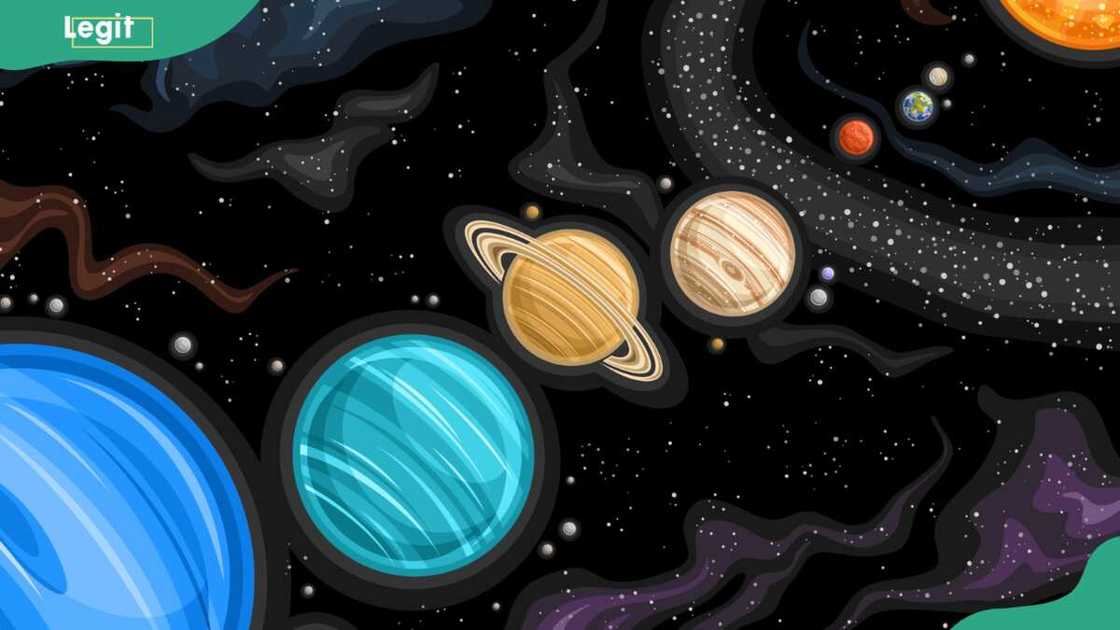
Source: Getty Images
William Herschel unsuccessfully attempted to honour King George III by naming it Georgium Sidus. However, Johann Bode proposed naming the planet Uranus after the Greek deity of the sky.
15. Uranus has a Greek god name
All planets except Uranus in the solar system have names derived from Roman gods. In contrast, a Greek god inspired its name. Caelus is Uranus' Roman equivalent.
16. Uranus formed 4.5 billion years ago
When the solar system was still forming, around 4.5 billion years ago, swirling gas and dust were drawn in by gravity to form the ice giant. It is most likely formed nearer the Sun, like Neptune, and travelled to the outer solar
17. Its magnetic field is tipped over
The magnetosphere of Uranus is unusually formed. Typically, magnetic fields align with a planet's rotation. The planet, however, has an asymmetric magnetic field, with its magnetic axis shifted from the planet's centre by one-third of its radius and tilted about 60 degrees off the planet's rotational axis.
18. Uranus does not support life
Its atmosphere is not suitable for supporting life. Therefore, creatures cannot likely adapt to the severe and cold variable temperatures, pressures, and materials that characterize this planet.
19. It has a twin
Neptune and Uranus are regarded as twin planets due to their striking similarities. Both planets are blue, and their diameters are around 50,000 kilometres. Neptune appears darker blue because there is less methane in the atmosphere than in Uranus, which is pale blue.
20. It is the third-largest planet
The third-largest planet in the Solar System is Uranus. Its diameter is roughly four times the Earth's, measuring 31,763 miles (51,118 kilometres). It has a volume around 63 times greater than the Earth's, where 63 Earths might fit inside it.
21. It's about 19AU away from the Sun
At 1.8 billion miles (2.9 billion kilometres) on average, Uranus is located roughly 19 astronomical units from the Sun. The sunlight travels this distance in around two hours and forty minutes.
22. Its moons are named after Shakespeare's characters
There are 27 moons known to exist on the planet, and they are all named after fictional characters from Alexander Pope and William Shakespeare. These names include Cordelia from King Lear, Titania from A Midsummer Night's Dream, and Prospero from The Tempest.
23. It has a peculiar tilt due to a collision

Source: Getty Images
According to NASA, Uranus may have collided with a planet the size of Earth, forcing its axis to change dramatically. The tilt causes it to experience the most extreme seasons in the solar system.
24. Its wind speed can reach 900 km/h
On Uranus, wind speeds can attain as high as 560 miles or 900 kilometres per hour. At the equator, winds are retrograde, meaning they blow against the direction of the planet's rotation. However, winds change to flow with their rotation in a prograde direction when they get closer to the poles.
25. Uranium is named after Uranus
In 1789, a German chemist, Martin Klaproth, found uranium in pitchblende and named the mineral after Uranus. The planet had been discovered eight years earlier.
What is Uranus made of?
The planet is a hot, dense fluid primarily composed of icy elements like water, methane, and ammonia. This fluid sits atop a tiny rocky core and accounts for 80% or more of the planet's mass.
How big is Uranus?
It is four times wider than Earth, with an equatorial diameter of 31,763 miles (51,118 kilometres). It would be roughly the size of a softball if Earth were as big as a nickel.
Is Uranus the coldest planet?
At an extremely low -224°C, the planet holds the lowest temperature recorded in the Solar System. Something massive struck it billions of years ago with such force that it tipped the planet onto its side.
How long is a day in Uranus?
A day on the planet is shorter than Earth because it rotates faster than Earth. On Uranus, a day lasts 17.24 Earth hours, but on Earth, 23.934 hours.
What is Uranus also known as?
It is also called the Tilted Giant because of its unusual tilted rotation, which gives the impression that it is spinning on its side. Along with Jupiter, Saturn, and Neptune, it is one of the giant planets.
Uranus has many fascinating facts and characteristics that you should know. If you are curious about the planet, look at the fun facts about Uranus above to add to your knowledge.
Legit.ng recently published an article on fun facts about Texas. Texas is located in downtown Austin, the capital and seat of government. Another name for Texas is the Lone Star State.
Several fascinating fun facts about Texas make many eager to visit the place. For instance, it has a natural lake called Caddo Lake, vast ranches with many cattle, and the largest park, Schlitter Galveston Waterpark. Read more in the article.
Source: Legit.ng

Isaac Wangethi (Lifestyle writer) Isaac Wangethi has been a content writer at Legit since September 2021. He has gained valuable experience working on various projects, such as celebrity biographies, lifestyle, news and many more. Isaac won the Writer of the Year Award on Legit in 2023. He earned a Bsc. of Science in Information Technology in 2017 from the University of Nairobi and a Higher Diploma in Computer Software Engineering from Gretsa University in 2021. In 2023, Isaac finished the AFP course on Digital Investigation Techniques. In March 2024, he completed the Google News Initiative course. Email: Wangethin@gmail.com

Mary Ugbodaga (Lifestyle Journalist) Mary Ugbodaga is a Legit.ng journalist with 7 years of experience in journalism and media communications. She graduated from Covenant University in 2018 with a Bachelor's degree in Mass Communication/Media Studies. Mary previously worked as a journalist at TheCable, CNBC AFRICA, Voice of Nigeria, KPMG Nigeria. Email: mary.ugbodaga@corp.legit.ng.


